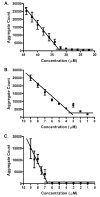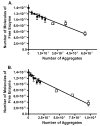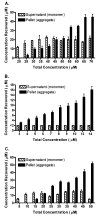Stoichiometry and physical chemistry of promiscuous aggregate-based inhibitors
- PMID: 18588298
- PMCID: PMC2627561
- DOI: 10.1021/ja802977h
Stoichiometry and physical chemistry of promiscuous aggregate-based inhibitors
Abstract
Many false positives in early drug discovery owe to nonspecific inhibition by colloid-like aggregates of organic molecules. Despite their prevalence, little is known about aggregate concentration, structure, or dynamic equilibrium; the binding mechanism, stoichiometry with, and affinity for enzymes remain uncertain. To investigate the elementary question of concentration, we counted aggregate particles using flow cytometry. For seven aggregate-forming molecules, aggregates were not observed until the concentration of monomer crossed a threshold, indicating a "critical aggregation concentration" (CAC). Above the CAC, aggregate count increased linearly with added organic material, while the particles dispersed when diluted below the CAC. The concentration of monomeric organic molecule is constant above the CAC, as is the size of the aggregate particles. For two compounds that form large aggregates, nicardipine and miconazole, we measured particle numbers directly by flow cytometry, determining that the aggregate concentration just above the CAC ranged from 5 to 30 fM. By correlating inhibition of an enzyme with aggregate count for these two drugs, we determined that the stoichiometry of binding is about 10,000 enzyme molecules per aggregate particle. Using measured volumes for nicardipine and miconazole aggregate particles (2.1 x 10(11) and 4.7 x 10(10) A(3), respectively), computed monomer volumes, and the observation that past the CAC all additional monomer forms aggregate particles, we find that aggregates are densely packed particles. Finally, given their size and enzyme stoichiometry, all sequestered enzyme can be comfortably accommodated on the surface of the aggregate.
Figures






References
-
- Rishton GM. Drug Discovery Today. 2003;8:86–96. - PubMed
-
- Hann MM, Oprea TI. Curr. Opin. Chem. Biol. 2004;8:255–263. - PubMed
-
- Roche O, Schneider P, Zuegge J, Guba W, Kansy M, Alanine A, Bleicher K, Danel F, Gutknecht EM, Rogers-Evans M, Neidhart W, Stalder H, Dillon M, Sjogren E, Fotouhi N, Gillespie P, Goodnow R, Harris W, Jones P, Taniguchi M, Tsujii S, von der Saal W, Zimmermann G, Schneider G. J. Med. Chem. 2002;45:137–142. - PubMed
-
- DeWitte RS. Drug Discovery Today. 2006;11:855–859. - PubMed
-
- Keseru G. Drug Discovery Today. 2006;11:741–748. - PubMed
Publication types
MeSH terms
Substances
Grants and funding
LinkOut - more resources
Full Text Sources
Other Literature Sources
Miscellaneous

